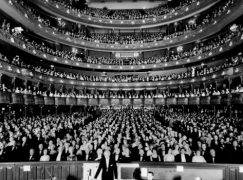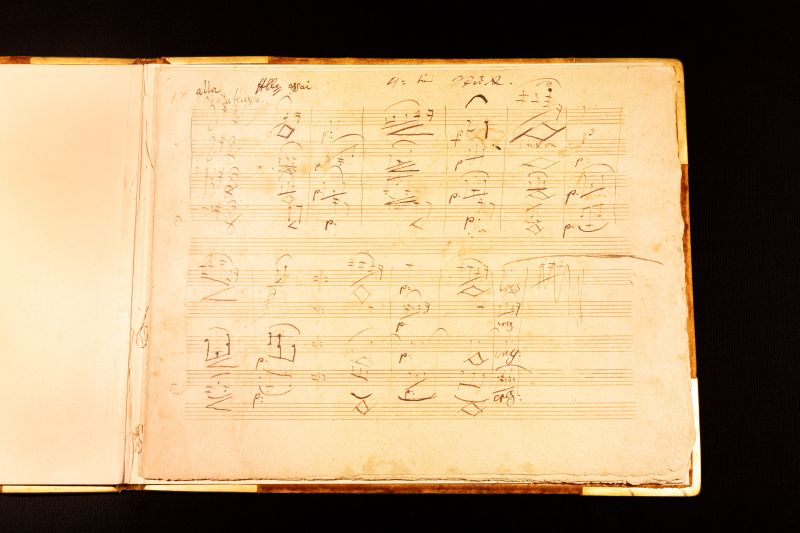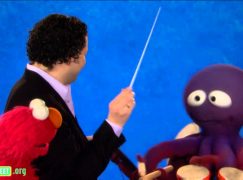Opera is unAmerican: discuss
OperaA wonderful memoir from Dana Gioia:
There was something shameful about loving opera. Especially for a boy. Opera was pretentious, boring, effete, and effeminate. By the time I was ten, I understood the unsavory reputation of the art. Opera represented everything that my childhood in postwar America asked me not to be.
I had never been to the opera. I had never even seen an opera house, except in old movies. I knew from the Marx Brothers’ A Night at the Opera that rich people went there, but they didn’t much enjoy it. Only Groucho had any fun. The patrons were old and overweight—bejeweled matrons and potbellied bankers stuffed into tuxedos. There was also something sinister about opera’s orgy of opulence. In Lon Chaney’s The Phantom of the Opera, the opera house was built over the city sewers. A mad composer emerged from this mephitic underworld to kidnap and kill. He wore elegant clothes, including an opera cape, but without his stylish mask, he was a monster. Opera was somehow both tedious and malevolent.
I wasn’t sure why opera provoked such distaste….
Read on here.






Beautifully written and a worthwhile read.
What a glorious article. It chimed with many of my own early experiences of music, especially Wagner. Dana Gioia is a great poet, an engaging writer and an inspiring man. He is now a good friend, and librettist of a work which was premiered in California last year. I conduct the UK premiere on 15 March at the Barbican with the BBC SO and their chorus – Fiat Lux.
Far from being unamerican (BTW, nowhere it says so in this article), this is a very American story of a first-generation immigrant. Yes, his tastes were different than that of a typical kid in a poor neighborhood. But this part of the story could have very well happened in any provincial British town. Not hard to imagine a poor but intelligent chap from Liverpool shining the Beatles for a Charlie Groves concert and being bullied for this. I can bet that there were a few of those.
Great story, beautifully written.
Unless you know your American opera history, most do not know that the Tivoli Opera House in San Francisco which launched Luisa Tetrazzini’s American career, was an old style, saw dust on the floor, hair in your whiskey bar akin to the Estates Theater in Prague which was designed for average people. The Metropolitan Opera House in the late 19th and early 20th Century was loaded every night they presented Italian opera by Italian immigrants who would scrap together their last nickels for a seat. In Colorado, there were opera houses opened for the gold rush miners. So the pretentious issue may have existed in some places, but certainly not everywhere.
Oh, there was certainly pretension there. Many, probably most, of those “opera houses” in smaller cities and towns (especially places like mining towns) never actually presented an opera. Closest they’d come might be a traveling opera singer doing a recital of arias and popular songs.
Those were theaters, and they’d be where you went to see vaudeville and the like. They were called opera houses simply because “opera house” sounded classier than “theater.”
Beautiful essay that likely resonates with many followers of Slippedisc. We classical music lovers do indeed feel isolated and abnormal when we’re getting started.
Getting started? I find them abnormal all along, as I can witness from close
Sally
A great essay — thanks for mentioning it.
If opera be un-American, sing on.
You don’t go to Europe to see West Side Story or Sound of Music, although some theaters there do them, notably La Scala.
there is a superb West Side Story in Paris. It’s a production from NYC
It is odd that Gioia, who was chairman of the NEA under George W. Bush between 2003 and 2009, does not discuss that governments play a significant role in creating the demographics for the arts. Appreciation for the fine arts is not a natural phenomenon, it is something created by societies and cultures.
Opera houses and opera performances were once quite common in the USA. With the advent of cinema, most of these houses fell into neglect because the USA did nothing to sustain opera as an art form. The issue was not demographics, but neglect. The same thing would have happened in Europe if they had not intervened.
From about 1930 to 1960, many US opera houses were destroyed. The magnificent Boston Opera House opened in 1909 and was demolished in 1958 to create a parking lot. Its acoustics were said to be excellent. The building was so solid that three different demolition companies were hired before one could do the job.
In 1980, Boston’s small remnant opera company moved into a repurposed movie theater that was given the name, Citizens Bank Opera House, but the company closed in 1990 due to financial problems. The house reopened in 2004 but is used mostly for the Boston Ballet, popular entertainment, and a venue for video game competitions. According to the last stats posted on Operabase, Boston ranked 250th in the world for opera performances per year.
The Philadelphia Metropolitan Opera House has a similar history. It was built in 1908 and ceased operations in 1934. For the next 50 years it gradually fell to ruin and was intermittently used as a movie theater, ballroom, sports venue, mechanic training center, and church. In 2017, it was renovated by Live Nation Philadelphia for popular entertainment.
The consequences of this neglect are obvious. According to the last stats on Operabase, Philadelphia ranked 109th for opera performances per year even though it has the 9th largest metro GDP in the world. They no longer use the opera house. The company’s productions are usually low budget with short runs done in often ill-suited rental facilities with pickup musicians. On the positive side, they approach these problems with creative verve and use them as a source of innovation.
The Philadelphia suburban area known as the Mainline has one of the largest concentrations of wealth on the planet while the city has some of the largest and most dehumanizing ghettos in the country. And worse, the ghettos are based on a racial class system. The city has the highest number of people living in deep poverty in the USA, including 60,000 children. Under the USA’s form of unmitigated capitalism, the neglect of cities and people can clearly be correlated with the neglect of the arts. When it comes to the fine arts, the issue is not demographics or trivialities like what boys think of opera, but concepts of government.
Detroit tells the same story. The original Detroit Opera House was built in 1868, destroyed by fire in 1897, and quickly rebuilt in less than a year. In 1931, it ceased operations and became a movie theater which also hosted burlesque shows and church services. In 1935, it was gutted and turned into a cut rate department store. In 1966, the building was demolished.
Today, as in Boston, Detroit’s opera company, Michigan Opera, works in a renovated movie theater. As in most US cities, there are few opera performances, so the venue is most often used for other purposes.
The movie theater renovated in Detroit had gone into steady decline as the city around it collapsed. It closed in 1978 after surviving several years exhibiting second-run and soft-core porn films. It briefly reopened again in 1981 but closed after a minor fire in 1985. Despite its troubles, Detroit still has the 24th largest metro GDP in the world but ranks 263rd for opera performances per year. This low number is normative for larger American cities. Opera is thus only a small part of its the house’s usage.
Nevertheless, the renovated theater has revived its Detroit neighborhood. The Michigan Opera recently received a $5 million grant, the largest in its history, but it should noted that the budget for state opera companies in European cities the size of Detroit are usually in the range of $150 million. With extensive educational programs and affordable tickets, they create large publics, do many more productions and performances, and give their artists far more financial security and respect. Again, concepts of government are more important than demographics. In terms of education, affordability, and reasonably nearby availability, it is the government that creates the demographic for the fine arts.
Europeans also enjoy genuine opera houses whose sight lines, acoustics, workshops, orchestra pits, lighting bays, and storage spaces are often better suited for opera than renovated movie theaters.
Many more examples of demolished opera houses could be discussed–opera houses that were really opera houses.
Americans often react resentfully when this history and these comparisons are mentioned. Like Gioia, they frequently attempt to rationalize a form of American exceptionalism that often leaves their cultural lives impoverished and large areas of their cities in ruins.
There are no greater heroes than the people working to revive and sustain opera in the USA.
I have a similar version of this essay on my website with photos of these old demolished opera houses and the renovated, repurposed movie theaters on my website. It is here:
http://www.osborne-conant.org/Aletheia-English.htm#Opera%20In%20the%20USA
Very interesting and very sordid…. the cultural destruction that certain types of modernity leave in their wake.
America once had an extensive public arts funding system similar to what Europeans still have. The Federal Theater Project existed for four years, from 1935 to 1939. Within a year it employed 15,000 people who created about 1200 productions (not including radio.) It played to an estimated 30 million people in more than 200 theaters nationwide, as well as in parks, schools, churches, clubs, factories, hospitals and closed-off streets. The photo below is of one of their performances.
From 1935 to 1943, the WPA hired about 10,000 visual artists who collectively created more than 100,000 paintings and murals and over 18,000 sculptures during the program’s 8 years of existence. A consistent goal of the WPA was to support and celebrate art in smaller cities and not just the big ones.
The Federal Theatre of the Air began weekly radio broadcasts March 15, 1936. It presented an average of 3,000 programs annually on commercial stations and the NBC, Mutual and CBS networks. Radio divisions were also created in 11 states.
Alas, the programs were eventually shut down mostly because the disruptions of WWII allowed reactionary Senators to slander the programs as too “socialist.” Sadly, today even the Democratic party has become part of the “too-socialist” mindset.
Please allow me one more comment. Another example of how opera was once supported in the USA was the NBC Opera Theater which existed from 1949 to 1964. The company performed a total of 43 operas for NBC, the majority of which were broadcast on the program NBC Television Opera Theatre. The organization’s work received 3 Primetime Emmy Award nominations. All the performances were broadcast live from a NBC studio. The program commissioned about ten new operas by composers ranging from Mennotti to Lukas Foss to Norman Dello Joio.
Mennotti’s beloved Amahl and the Night Visitors was commissioned by NBC and first performed by the NBC Opera Theatre on December 24, 1951, in New York City at NBC Studio 8H in Rockefeller Center, where it was broadcast live on television from that venue as the debut production of the Hallmark Hall of Fame. It was the first opera specifically composed for television in the United States.
Europe continues this sort of publicly funded arts activity to this day. Operas are regularly broadcast on public television. Americans do not realize the extent to which their country and cultural lives were strongly damaged by postwar political and economic philosophies that destroyed our systems of public arts funding – a situation that in some respects is a form of oppression.
Excellent posts. Adding to the post-WWII anti-socialist purge and cultural destruction of the arts, there had been an immigration shift from Europe to other parts of the world to whom “opera” and “classical music” meant little if not high-minded eliticism. These new immigrants later became city and state lawmakers resulting in further reduction in arts funding.
And with all that private wealth the U.S. has, most of it is the tech nouveau-riche who do not give to the arts. For the most part it’s the old money donors who support the arts.